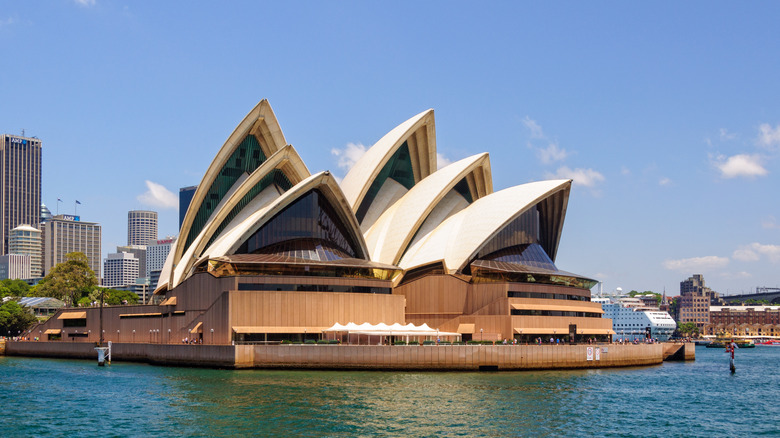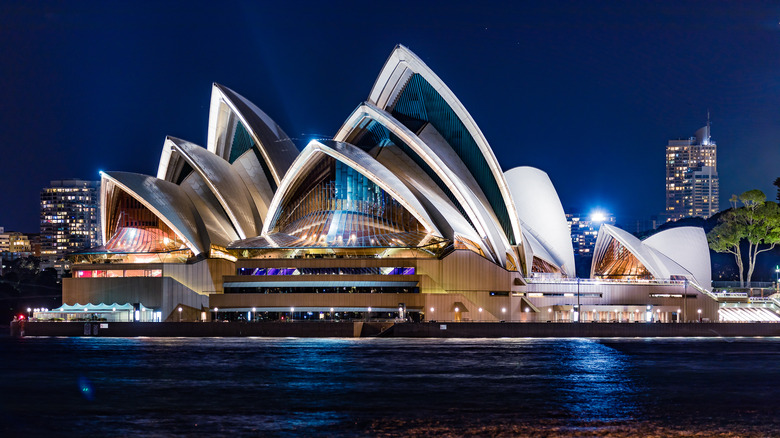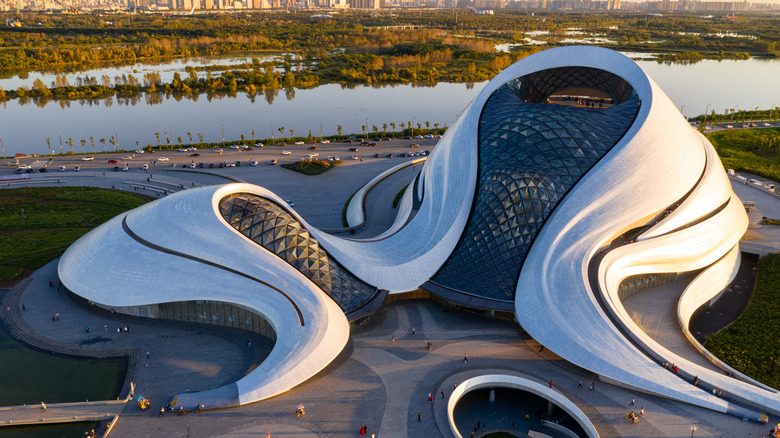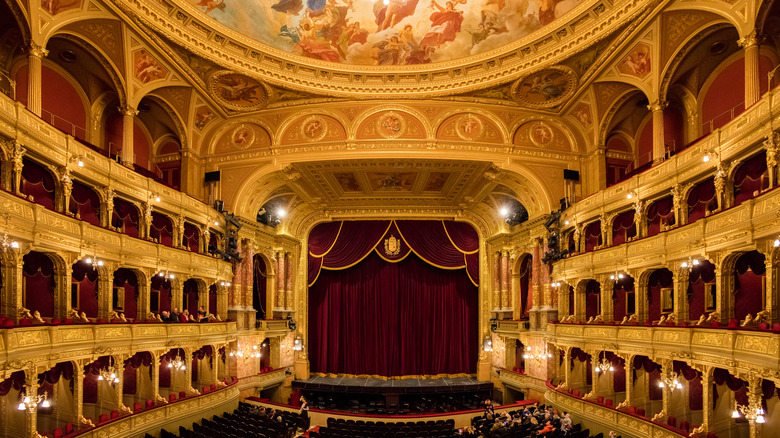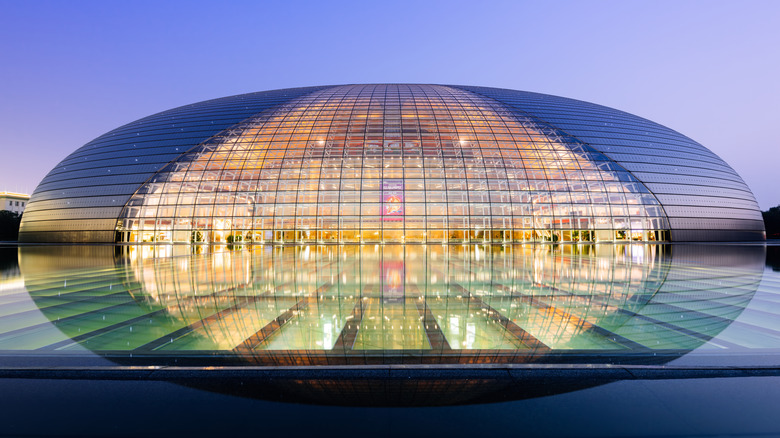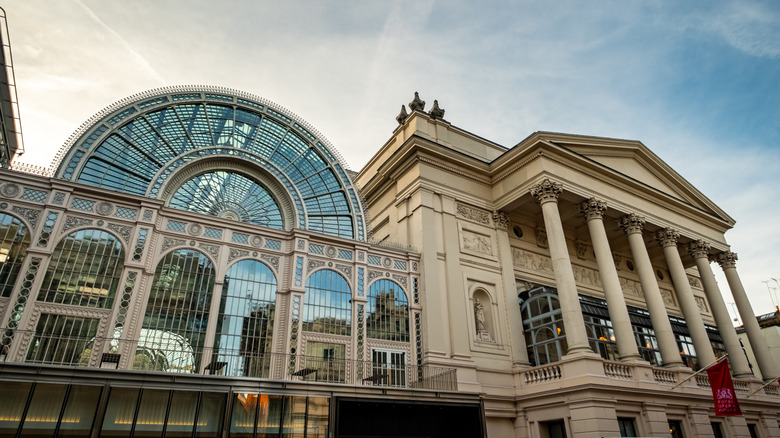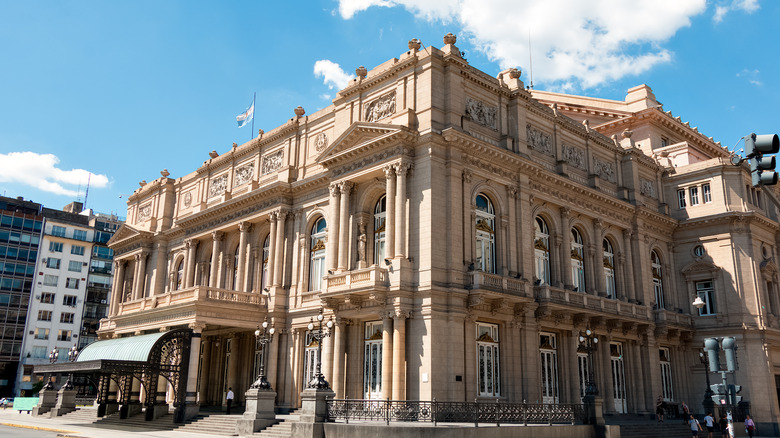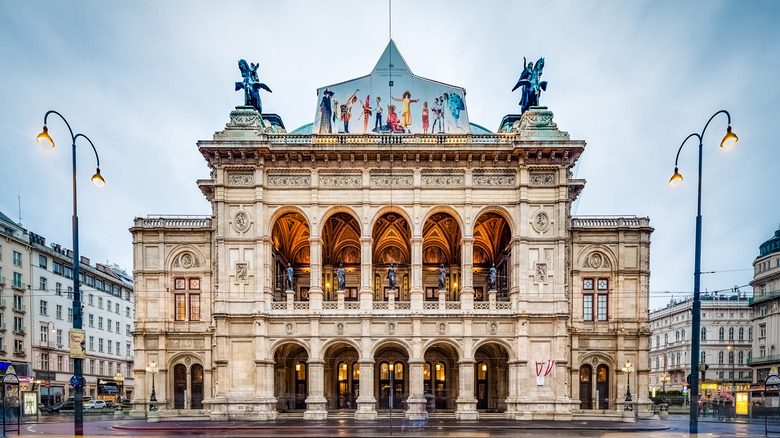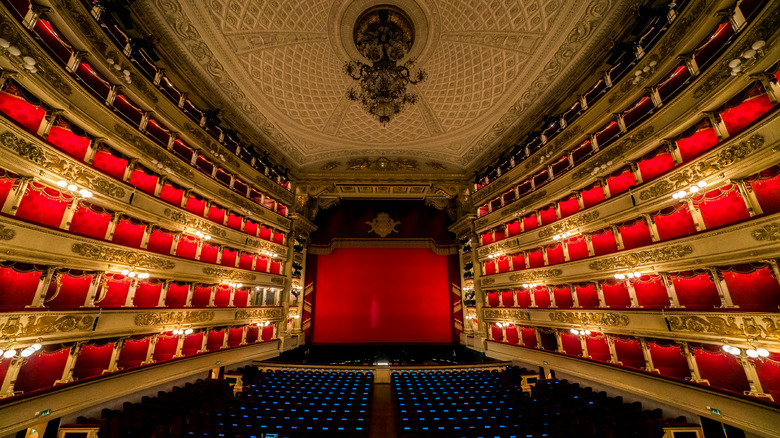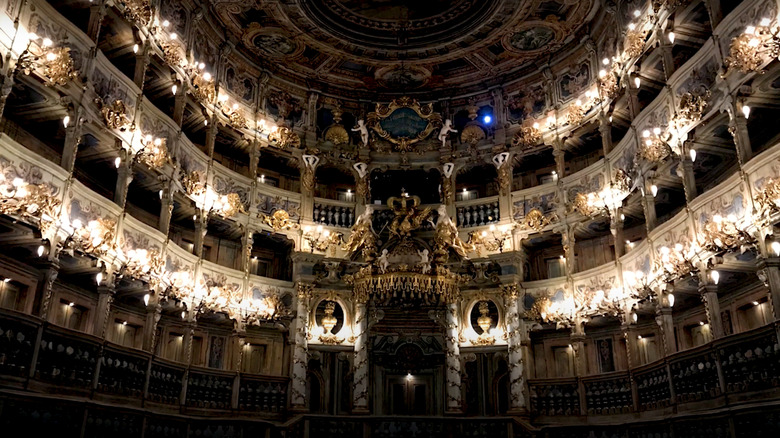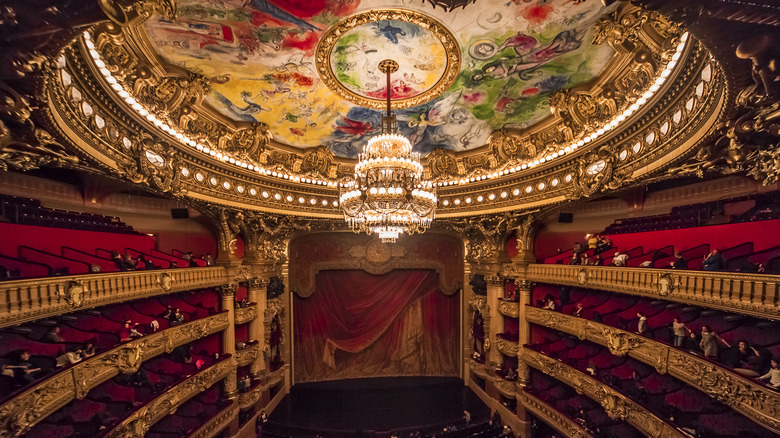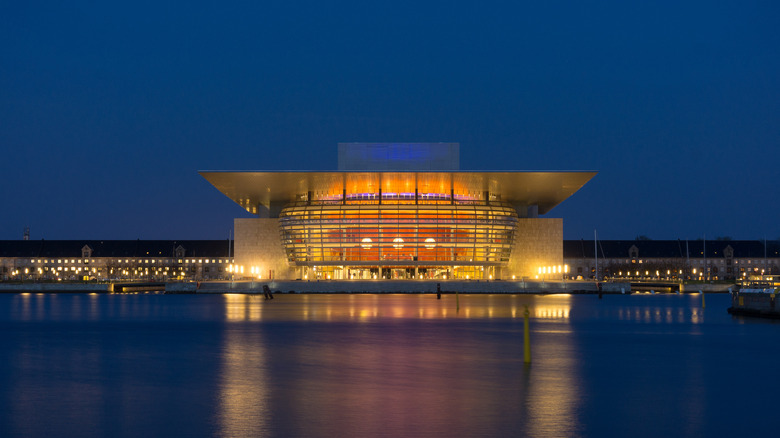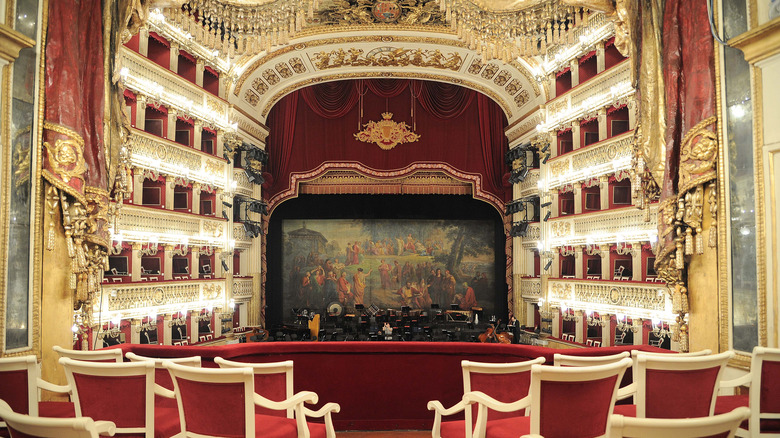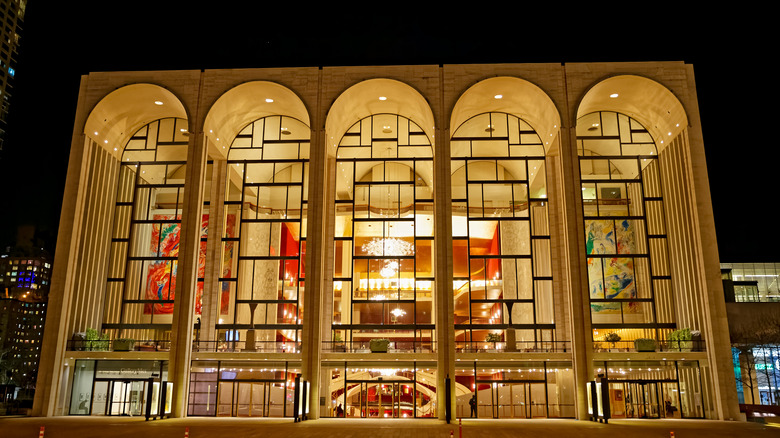The Most Stunning Opera Houses Around The World
There's nothing quite like a night at the opera. From the music and costumes to the stories and stage design, these epic performances have been delighting audiences for hundreds of years. At its heart, opera is an art form that expresses emotion through soaring music, dramatic plots, and powerful singing. As characters sing their way through emotional highs and lows, it's hard not to be captivated.
Perhaps the only thing that rivals the magnificence of opera are the places where it is performed. Stepping inside these beautiful and culturally significant buildings is like entering another world filled with grand staircases, gold-leaf trim, stunning décor, and crystal chandeliers. Whether you are an opera lover or have never seen a single performance in your life, the world's grandest opera houses are undeniably special, per National Geographic. Often built to reflect the wealth and importance of a city, these buildings are worth visiting for their architecture alone. We're taking a tour of opera houses around the world, counting down the most amazing historic landmarks and striking contemporary structures that have us saying bravo.
The Sydney Opera House features over one million ceramic tiles
As one of the most recognized buildings in the world, the Sydney Opera House soars impressively into Sydney's shimmering skyline. The UNESCO World Heritage Site was originally designed by Danish architect Jørn Utzon as part of an international competition announced by the Australian government in 1956. However, the path to completion was marked by construction challenges and tension between the architects and government. At first, Utzon had to redesign the geometry of the shells after they were declared structurally impossible by the project's engineers. Then, Utzon struggled to receive adequate funds from the government and he eventually resigned. He never returned to Australia again, even to see the finished opera house.
New architects were appointed to the project after Utzon left and the completed opera house was officially unveiled in 1973 by Queen Elizabeth II. In total, it cost $102 million to build. The striking building draws inspiration from Mayan architecture and features billowing white sails, lined with over one million ceramic tiles, per Culture Trip. The interiors include an opera house, concert hall, playhouse, and a studio. Despite its checkered past, this opera houses is one of the most photographed buildings in the world and continues to stand as an artistic achievement and one of the finest examples of modern architecture.
Harbin Opera House reflects its natural surroundings
Surrounded by a landscape of wild wetlands, China's Harbin Opera House blends effortlessly into its natural environment. This striking contemporary structure was created by MAD Architects, a Beijing design firm, with the goal of embodying the city's "untamed wilderness and frigid climate," according to Yatzer. The 850,349-square-foot opera house is certainly a fitting cultural center for Harbin, which is nicknamed "Ice City."
Completed in 2015, the building's exterior is constructed from white aluminum panels and transparent glass walls. Inside, there is a grand lobby space and a main theater sculpted from Manchurian Ash, which flows elegantly around the central stage and seating area. One of the most unique architectural features is located within the second, smaller theater. Here, a soundproof glass wall looks out onto the outside world providing a naturally scenic backdrop. For amazing panoramic views over Harbin, visitors can climb up to a viewing platform via stairs that spiral around the outside of the opera house.
The Hungarian State Opera House is known for high-quality acoustics
Located in the center of Budapest, the Hungarian State Opera House is a masterpiece from head-to-toe. This neo-Renaissance building was designed by one of Hungary's most noteworthy architects, Miklós Ybl, who exclusively used materials produced within Hungary. It has been an important landmark in Budapest since it was completed in 1884, per U.S. News & World Report, and continues to charm visitors.
While it is not among Europe's largest opera houses in terms of capacity, the Hungarian State Opera has a reputation for beauty and quality. The high-quality acoustics, glittering bronze chandelier, and interior spaces decorated by acclaimed Hungarian artists are all highlights. The vaulted ceilings are also covered with impressive murals, illustrating a variety of Greek myths. Even if you can't make it inside, the building's exterior is worth a stop alone. It is covered with statues of opera greats such as Mozart, Liszt, Puccini, and Verdi.
The National Grand Theatre in Beijing is nicknamed 'The Egg'
Beijing's National Grand Theatre is a record-breaking destination. Not only is it the largest performing arts center in the world, but "the Egg" is also the deepest building in Beijing and the home of China's largest pine organ. This impressive landmark hosts high-caliber events from all over the world, including operas, musicals, ballets, and traditional Chinese performances. The creation of Paul Andreu, a French architect, the glittering glass and titanium dome received a fair amount of criticism after its construction in 2007 due to its unconventional appearance. Many people thought the contemporary design did not adequately reflect Chinese culture or heritage, as noted by Beijing Visitor. However, it has also been said to resemble a baozi, Chinese steamed bread, thanks to its unique shape.
No matter how one feels about the futuristic theater, it is undoubtedly a one-of-a-kind sight. Surrounded by a large pool, the building looks like it's hovering on the water's surface. To enter the theater, visitors must travel through one of the transparent underwater passageways. It's like leaving the normal world behind for a place of pure imagination.
Many legends have graced the stage of the Royal Opera House at Covent Garden
For generations, the Royal Opera House in England has been stirring emotions and enchanting hearts with its artistic performances. The story of the opera house begins in 1732, when the first theater was built on this site. After fire destroyed the theater twice, the current building was constructed in 1858. During its early years the theater was used for lectures, cabarets, and film shows in between opera seasons, and even functioned as a dance hall during World War II, according to the Royal Opera House's website. After the war, the Royal Opera House became exclusively used for opera and ballet. The modern glass hall that was once Covent Garden's flower market is now the opera's main entrance hall and public space, complementing the neighboring main opera house.
Since its establishment as a permanent home for operatic performances, the Royal Opera House has hosted many legends. Performers such as Maria Callas, Jon Vickers, Joan Sutherland, and Luciano Pavarotti have all made appearances, and the opera house continues to invite both emerging and established talents to its grand stage.
Teatro Colón has a history as dramatic as an opera plot
Thanks to its beautiful architecture and state-of-the-art acoustics, the Teatro Colón is among the best opera houses in the world and a symbol of Argentina. The seven-story theater contains many treasures, including a sparkling chandelier that weighs five tons. However, the building's history is as dramatic as an opera plot. During the construction period, the project's leading architect changed three times. The first architect, Francesco Tamburini, passed away a year after creating the building's initial plans. His partner, Víctor Meano, subsequently assumed leadership and oversaw construction. Just four years before the project was finished, Meano found his wife in bed with his valet. A confrontation followed and Meano was killed by his servant, via Wander Argentina. His wife was deported to Italy and the man sentenced to 17 years in prison.
Eventually the Teatro Colón was completed in 1908 and opened with a performance of Aida. Today, visitors can catch a performance at this historic opera house or take a guided tour of the richly decorated interiors.
The Vienna State Opera is pure opulence
Ask any opera lover about the world's best opera houses and the Vienna State Opera is almost guaranteed to make the list. This magnificent building first opened its doors in 1869 with a presentation of Mozart's Don Juan, and has been known for world-class opera programs and performances ever since. The front entrance of this Renaissance Revival building is decorated with arches and statues on horseback, while the opulent interiors are dressed to impressed with 22 carat gold leaf on the ceilings and walls, according to the Wiener Staatsoper. One of the main treasures inside is the well-preserved Tea Salon. This gorgeous room has not changed much since Emperor Franz Joseph sipped his tea here in the 19th century.
Despite its impressive appearance, the opera house did not escape damage during World War II. Nazis prevented many works from being performed during the war years and bombs severely destroyed parts of the building in 1945. It took over 10 years for the opera house to be restored back to its original glory. Now, the opera house is recognized internationally for its diverse operatic program and large repertoire.
La Scala is synonymous with opera
Synonymous with opera, La Scala is one of the most revered opera houses in history. This grand Milan building dates back to 1778, when it was built on the site of a former church at the request of Archduke Ferdinand. During its early years, the theater was lit by thousands of candles and had a magical atmosphere during performances. Additionally, the opera house not only presented great works of opera, but was also instrumental in spreading opera's popularity. The highest level of seats known as "loggione" (referred to nowadays as the nosebleed section) were offered at lower prices, making it possible for people from different social classes to attend the opera. However, this section of the audience was notoriously difficult to win over and even opera greats like Pavarotti struggled to impress these seats.
Over the years, a number of interesting events took place at La Scala (apart from the opera). The building's foyer once functioned as a gambling hall, irritating opera-goers like Mary Shelley, the author of "Frankenstein." Per Classic FM, Shelley complained that the loud gambling made it difficult to hear the opera itself. The opera house was also bombed during World War II, but the bombs that hit the building did not explode. Today, the opera house's museum documents its long history and the many talents that have appeared on the famous stage.
The Margravial Opera House is a UNESCO World Heritage Site
Known for its connection to composer Richard Wagner, Bayreuth is a small German town with an impressive opera house. According to UNESCO, the lavish theater charmed Wagner so much that he decided to build his festival venues in Bayreuth. Known as the Margravial Opera House, the magnificent structure was designed by Giuseppe Galli Bibiena, the top architect of the time, and completed in 1750. The interior was finished in just four years, since many of the architectural pieces were painted and created in other parts of Europe. It was styled after great opera houses of the age, such as the ones in Vienna, Dresden, and Paris, and remains the only perfectly preserved Baroque theater of its kind. Since the building still features the original wood construction, contemporary audience members can experience the sights and sounds of an authentic 18th century performance.
After the opera house was designated a UNESCO World Heritage Site in 2012, a series of renovations began that lasted six years. In total, the restoration process cost €30 million (nearly $34 million) and required a team of 30 conservators to remove layers of dirt from the paintings.
Palais Garnier inspired The Phantom of the Opera
The prestigious Palais Garnier opera house is famously the setting for French detective novelist Gaston Leroux's "Phantom of the Opera." The building, which was designed by architect Charles Garnier, features stunning interiors complete with a marble staircase, gilded paintings, and a renowned painted stage curtain. The massive, 7-ton chandelier hanging above the audience might sparkle innocently, but in 1896 one of the supporting counterweights broke and fell, killing a concierge. The tragic event inspired the fictional "Phantom of the Opera," which was later turned into a musical by Andrew Lloyd Weber.
According to CGTN News, there is a secret lake beneath the opera house, just like in the book. It is currently used as a fire reservoir and is closed off from the public. Other noteworthy aspects of Palais Garnier include the painted ceiling by artist Marc Chagall and the impressive stage.
The Royal Danish Opera House is one of the most expensive opera houses ever built
With a price tag of $500 million, The Royal Danish Opera House is the one of the most expensive opera houses ever built. While the building certainly has its fair share of fans, it still receives plenty of criticism, as noted by the Danish Architecture Center. Even the building's architect, Henning Larsen, was disappointed with the way it turned out and said the completed structure resembled a toaster.
Whether you love or hate the design, the landmark is hard to ignore. The massive building holds a prominent position in Copenhagen's harbor and contains more than 1,000 rooms. The main auditorium seats an audience of 1,450 and has a ceiling adorned with 105,000 24-carat gold leaf sheets. Masterful acoustics and state-of-the-art stage systems allow for great experiences of live opera. Inside the grand foyer, suspended balconies and stairs set the stage for audience members to see and be seen between performances.
Teatro di San Carlo is the oldest opera house in the world
Naples might be known for its pizza and inimitable culinary scene, but the Italian city's art and architecture is just as inspiring. One of the most historic gems in Naples is the Teatro di San Carlo, which is widely regarded as the world's oldest opera house. The building, which originally opened in 1737, is home to the oldest continually running public opera and has witnessed wars, fires, and revolution. While the opera house burned down in 1816, the reconstruction remained true to the original, according to Lonely Planet.
Tradition has certainly made its mark on the theater, especially within the box seats. Inside, there are still mirrors angled towards the original royal box. These were installed because opera-goers were supposed to react in the same way to the performance as the king. Today, viewers can take in a show or go on a guided tour of the historic theater, including its foyer, main hall, auditorium, and royal box.
The Metropolitan Opera House was founded by wealthy New York industrialists
The story of the Met Opera begins in 1883 with a group of wealthy New York industrialists who wanted to start their own theater. At the time, the only opera in New York was the exclusive Academy of Music and there was only space for the "Old Money" families, per History Today. John D. Rockefeller, William H. Vanderbilt, and members of the Morgan and Roosevelt families came together to build a new opera house on Broadway and 39th Street where they would be welcome. The new theater was a great success, engaging many great artists such as Christine Nilsson and Marcella Sembrich during the inaugural season.
In 1966, the opera moved to its current location at Lincoln Center. Even compared to lofty European opera standards, the majestic new building impresses with revolving stages, crystal chandeliers, and underground floors — not to mention two beautiful murals from artist Marc Chagall hanging in the window.
